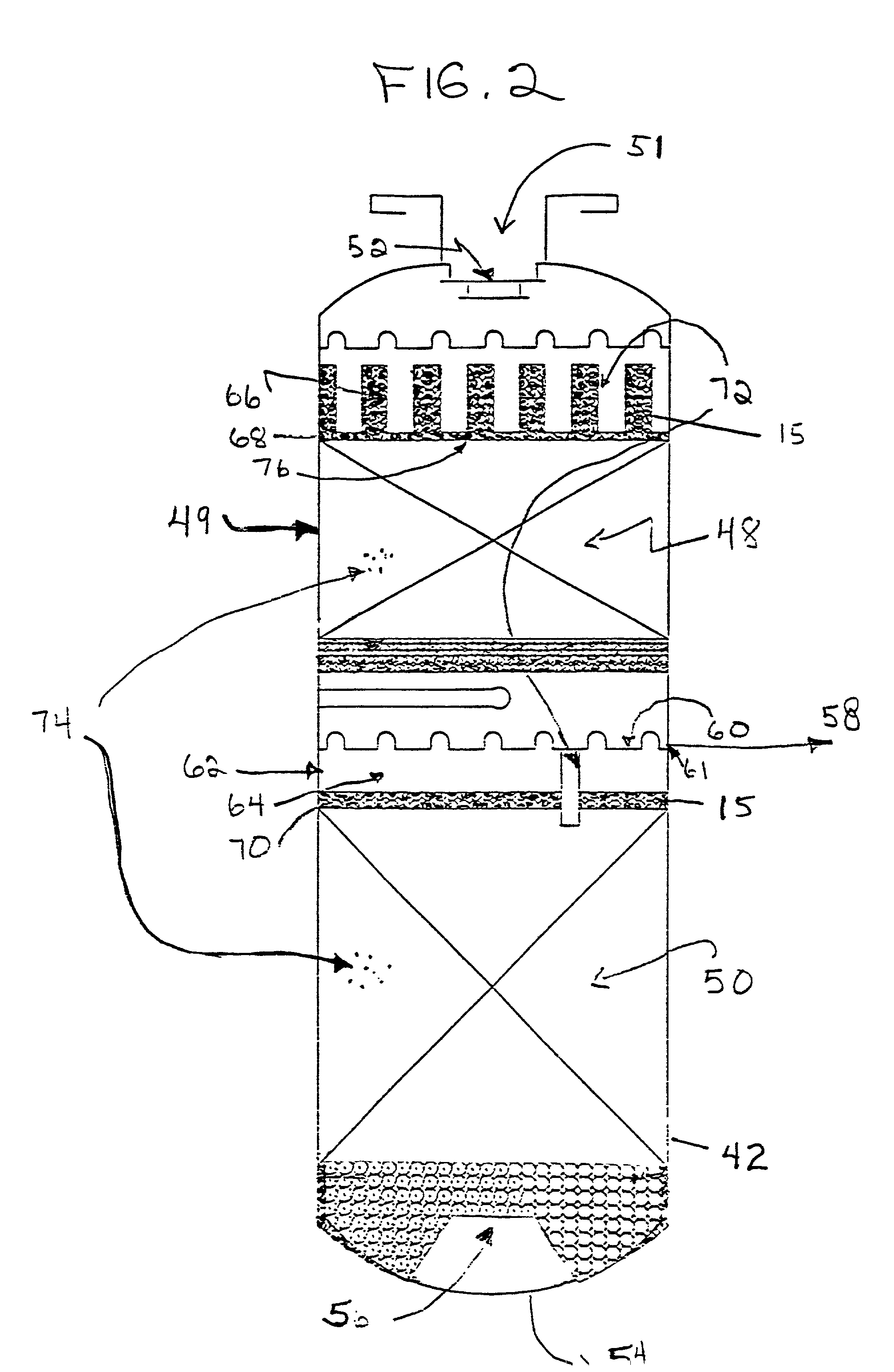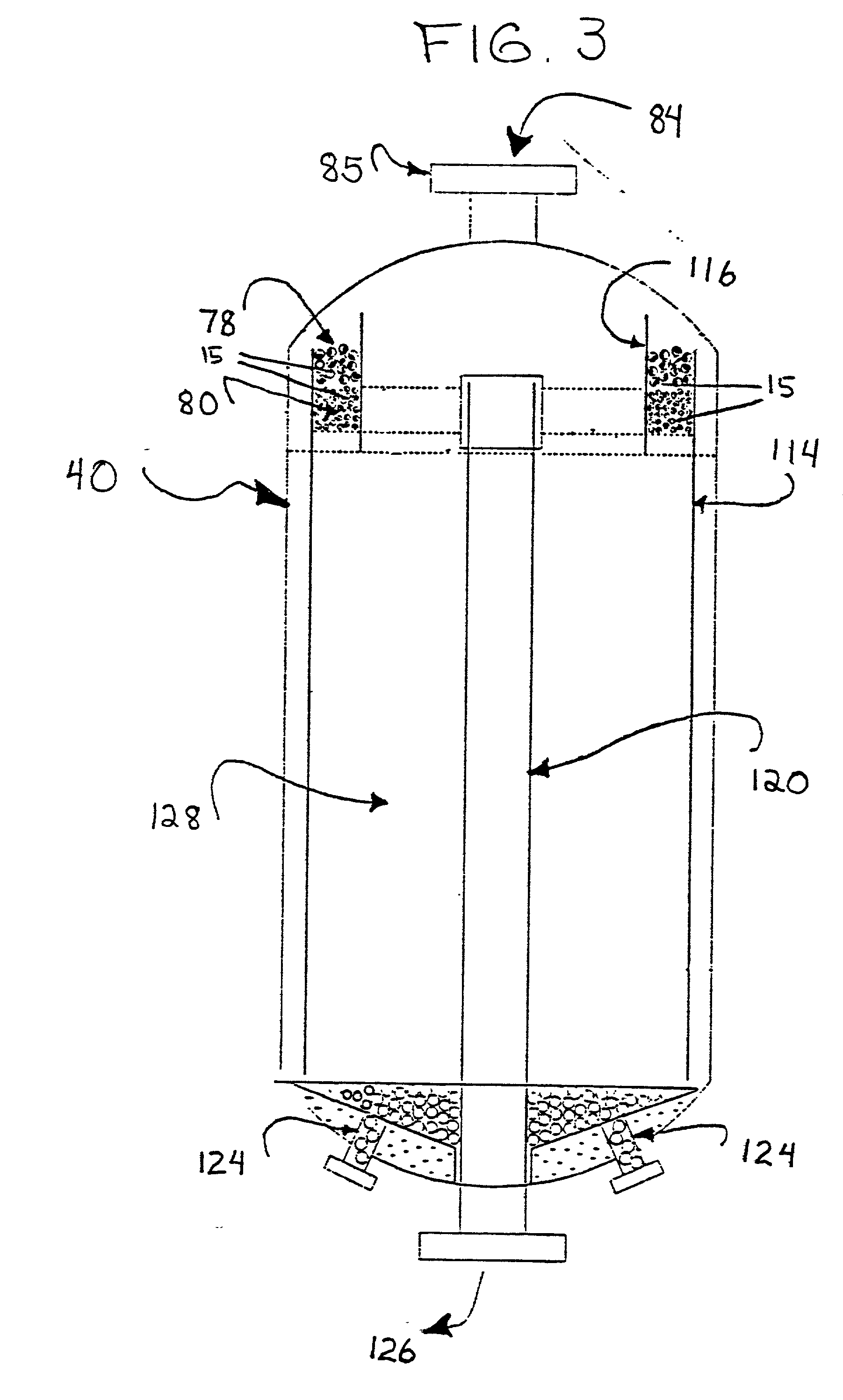[0011] In accordance with the invention, the foregoing advantages may be achieved through the present media and methods of filtering and distributing an organic-based feed for chemical reactors. The filtering medium of the present invention includes a plurality of
ceramic filter units, at least some of the
ceramic filter units having a plurality of openings extending therethrough, and at least some of the openings selected from the group of ellipses or trisoids. The elliptical and trisoidal shaped openings are believed to increase particulate
trapping. The elliptical and trisoidal shaped openings create an area of reduced
liquid velocity, similar to that in a bend of a river.
Sedimentation may occur on the inside of the turn, or river bend, while no particulate
trapping occurs on the outside of the turn. The ceramic filter units may be made from any commercially available ceramic precursors including fire clays such as
ball clay or
silicate-aluminum clays such as
montmorillonite clays or preferably,
kaolinite clay. Optionally, ceramic precursor powders such as
cordierite,
mullite, zirconia stabilized with magnesia or calcia,
zirconia toughened alumina, and the like may be used. The ceramic filter units may be formed by molding,
stamping, pressing or preferably, by
extrusion.
[0013] The periphery surface of the ceramic filter units may be provided with flutes. As used herein, the term flutes encompasses both flutes and grooves. The ceramic filter units also have top and bottom surfaces. These top and bottom surfaces are generally smooth. However, another feature of the present invention may include contacting the
solid particles with the ceramic filter units have top and bottom surfaces, wherein at least one of the top and bottom surfaces are irregularly shaped. A preferred embodiment has irregularity shaped top and bottom surfaces which have ridges, rounded beads, or
waves. The irregular surfaces provide protruding areas to contact the entrained solids, reducing the
particle velocity below of the fluid, effectively removing entrained solids. The liquid flowing over the irregular surface is induced to form eddies, which in turn forces more entrained solids to contact the ceramic filter units' irregular surface, removing more entrained solids. Another feature of this aspect of the preset invention is that the amplitude and length of the
waves of ridges may be adjusted based upon the particles sizes, fluid velocity and
viscosity.
[0023] The method of the present invention is useful to extend the run life of the catalyst bed. Catalytically active ceramic filter units may be utilized to react diolefins or other polymer precursors and also to act as a filter and
distributor. By filtering solids and partially reacting any polymer precursors, e.g., diolefins, fouling of the bed is reduced, effectively extending the run time of the reactor. In accordance with another aspect of the present invention, the step of contacting the contaminated organic-based feed stream with the ceramic filter units may include depositing a catalyst on at least some of the ceramic filter units prior to contacting the contaminated organic-based feed stream. Another feature of this aspect of the present invention may include the use of at least some ceramic filter units having a plurality of openings selected from the group consisting of ellipses and trisoids as a substrate having a substantially uniform
coating of a selected catalyst including a porous
alumina coating with a Group VI-B
metal or a Group VIII
metal, or both. Preferably, the Group VI-B
metal is
molybdenum and preferably, the Group VIII metal is either
nickel or
cobalt. More preferably, the Group VI-B metal and Group VIII metal are impregnated into at least some of the ceramic filter units having a plurality of openings extending therethrough, at least some of the openings having a shape selected from the group consisting of ellipses and trisoids. In another embodiment of this invention, at least some of the ceramic filter units used may comprise a porous
inorganic oxide selected from the group consisting of
alumina, silica, silica-
alumina, magnesia, silica-magnesia and titania. At least some of the ceramic filter units used in the present invention may also be a metal
oxide, metal
nitride, or metal
carbide selected from the group consisting of
titanium,
zirconium,
tungsten,
silicon or
boron. Another feature of this aspect of the present invention is using at least some ceramic filter units comprising a
metal boride selected from the group consisting of
titanium,
zirconium or
tungsten. Still a further aspect of the present invention includes using at least some ceramic filter units comprising a
zeolite selected from the group consisting of
zeolite L,
zeolite X and zeolite Y.
[0025] The method of the present invention for filtering organic-based feed streams in chemical reactors, when compared with prior art methods, has the advantages of: reducing the volume of
ceramic materials required; lowering capital costs; improving the
filtration of the solid particular matter from the feed streams; decreasing the pressure drop across the
system; increasing run time of the reactor; lowering operating costs; increasing
process safety; and reducing environmental concerns.
 Login to View More
Login to View More 


